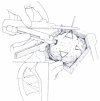Surgical management of penetrating pulmonary injuries
- PMID: 19236703
- PMCID: PMC2650680
- DOI: 10.1186/1757-7241-17-8
Surgical management of penetrating pulmonary injuries
Abstract
Chest injuries were reported as early as 3000 BC in the Edwin Smith Surgical Papyrus. Ancient Greek chronicles reveal that they had anatomic knowledge of the thoracic structures. Even in the ancient world, most of the therapeutic modalities for chest wounds and traumatic pulmonary injuries were developed during wartime. The majority of lung injuries can be managed non-operatively, but pulmonary injuries that require operative surgical intervention can be quite challenging. Recent progress in treating severe pulmonary injuries has relied on finding shorter and simpler lung-sparing techniques. The applicability of stapled pulmonary tractotomy was confirmed as a safe and valuable procedure. Advancement in technology have revolutionized thoracic surgery and ushered in the era of video-assisted thoracoscopic surgery (VATS), providing an alternative method for accurate and direct evaluation of the lung parenchyma, mediastinum, and diaphragmatic injuries. The aim of this article is to describe the incidence of the penetrating pulmonary injuries, the ultimate techniques used in its operative management, as well as the diagnosis, complications, and morbidity and mortality.
Figures






Similar articles
-
Urgent thoracotomy for penetrating chest trauma: analysis of 158 patients of a single center.Injury. 2011 Sep;42(9):900-4. doi: 10.1016/j.injury.2010.02.004. Injury. 2011. PMID: 22081815
-
Lung-sparing surgery after penetrating trauma using tractotomy, partial lobectomy, and pneumonorrhaphy.Arch Surg. 1999 Feb;134(2):186-9. doi: 10.1001/archsurg.134.2.186. Arch Surg. 1999. PMID: 10025461
-
Pulmonary tractotomy with selective vascular ligation for penetrating injuries to the lung.Am J Surg. 1994 Dec;168(6):665-9. doi: 10.1016/s0002-9610(05)80141-2. Am J Surg. 1994. PMID: 7978015 Clinical Trial.
-
Penetrating injuries of the chest: indications for operation.Scand J Surg. 2002;91(1):41-5. doi: 10.1177/145749690209100107. Scand J Surg. 2002. PMID: 12075833 Review.
-
Video-assisted thoracoscopic surgery for retained hemothorax in blunt chest trauma.Curr Opin Pulm Med. 2015 Jul;21(4):393-8. doi: 10.1097/MCP.0000000000000173. Curr Opin Pulm Med. 2015. PMID: 25978625 Free PMC article. Review.
Cited by
-
A civilian perspective on ballistic trauma and gunshot injuries.Scand J Trauma Resusc Emerg Med. 2010 Jun 17;18:35. doi: 10.1186/1757-7241-18-35. Scand J Trauma Resusc Emerg Med. 2010. PMID: 20565804 Free PMC article. Review.
-
Thoracoscopic repair of penetrating lung trauma with pulmonary tractotomy: a case report.Gen Thorac Cardiovasc Surg Cases. 2025 May 26;4(1):25. doi: 10.1186/s44215-025-00209-2. Gen Thorac Cardiovasc Surg Cases. 2025. PMID: 40420151 Free PMC article.
-
Outcomes after pneumonectomy versus limited lung resection in adults with traumatic lung injury.Updates Surg. 2020 Jun;72(2):547-553. doi: 10.1007/s13304-020-00727-4. Epub 2020 Feb 21. Updates Surg. 2020. PMID: 32086773 Free PMC article.
-
Successful Tractotomy Technique for a Penetrating Lung Injury in a Patient with One Lung.Korean J Thorac Cardiovasc Surg. 2017 Oct;50(5):399-402. doi: 10.5090/kjtcs.2017.50.5.399. Epub 2017 Oct 5. Korean J Thorac Cardiovasc Surg. 2017. PMID: 29124035 Free PMC article.
-
Treatment of open chest rib fractures with the matrix rib internal fixation system: A case report.Medicine (Baltimore). 2019 May;98(20):e15683. doi: 10.1097/MD.0000000000015683. Medicine (Baltimore). 2019. PMID: 31096506 Free PMC article.
References
-
- Breasted JH, (Ed) The Edwin Smith Surgical Papyrus. Vol. 1. University of Chicago Press, Chicago, IL; 1930. pp. 369–373.
-
- Homer The Iliad. Translated by Alexander Pope. George Bell & Sons, London. 1904;XVI:299–lines 588–625.
-
- Bellamy RF, Zajtchuk R. The evolution of wound ballistics: a brief history. In: Bellamy RF, Zajtchuk R, editor. Textbook of Military Medicine, Office of the General Surgeon. Department of the Army. Washington, DC; 1989. pp. 83–106.
Publication types
MeSH terms
LinkOut - more resources
Full Text Sources
Other Literature Sources
Medical

